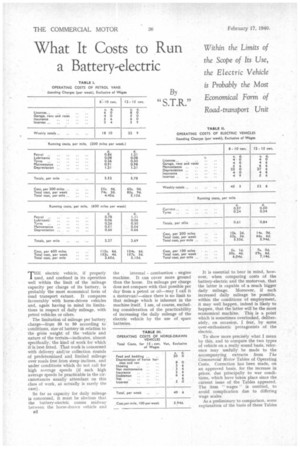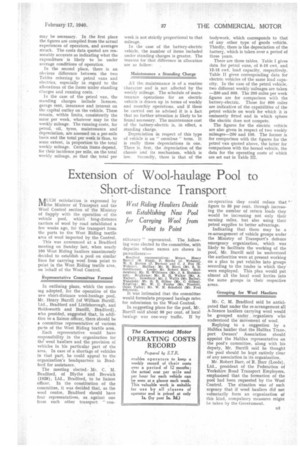What It Costs to Run a Battery-electric
Page 28

Page 29

If you've noticed an error in this article please click here to report it so we can fix it.
THE electric vehicle, if properly used, and confined in its operation well within the limit of the mileage capacity per charge of its battery, is probably the most economical form of road transport extant. It compares favourably with horse-driven vehicles and, again having in mind its limitations in respect of daily mileage, with petrol vehicles or oilers.
The limitation of mileage per battery, charge-from 30 to 50 according to conditions, size of battery in relation to the gross weight of the vehicle and nature of the terrain-indicates, almost specifically, the kind of work for which it is best fitted. That work is concerned with delivery and/or collection rounds of predetermined and limited mileage over roads free from steep inclines, and under conditions which do not call for high average speeds (if such high average speeds be practicable in the circumstances usually attendant on this class of work, as actually is rarely the case).
So far as capacity for daily mileage is concerned, it must be obvious that the battery-electric comes midway between the horse-drawn vehicle and the internal combustion engine machine. It can cover more ground than the horse. Its mileage per charge does not compare with that possible per day from a petrol or oil-may I call it a motorvan?-since there is no limit to that mileage which is inherent in the machine itself. I am, of course, excluding consideration of the practicability of increasing the daily mileage of the electric vehicle by the use of spare batteries. It is essential to bear in mind, however, when comparing costs of the battery-electric and the motorvan, that the latter is capable of a much bigger daily mileage. Moreover, if such increased daily mileage be possible, within the conditions of employment, it may well happen, indeed is likely to happen, that the latter will be the more economical machine. This is a point which is sometimes overlooked, deliberately, on occasion, I fear, by some over-enthusiastic protagonists of the electric.
To show more precisely what I mean by this, and to compare the two types of vehicle on a really sound basis, reference may usefully be made to the accompanying extracts from The Commercial Motor Tables of Operating Costs. Correction has been made, on an approved basis, for the increase in prices, due principally to war conditions, which have taken place since the current issue of the Tables appeared. The item " wages " is omitted, to avoid complication due to differing wage scales.
As a preliminary to comparison, some explanation of the basis of these Tables may be necessary. In the first place the figures are compiled from the actual experiences of operators, and averages struck. The costs data quoted are reasonably accurate as indicating what the expenditure is likely to be under average conditions of operation.
In the second place, there is an obvious difference between the two Tables referring to petrol vans and electrics, especially in regard to the allocations of the items under standing charges and running costs.
In the case of the petrol van, the standing charges include licences, garage rent, insurance and interest on the capital outlay on the vehicle, These remain, within limits, consistently the same per week, whatever may be the weekly mileage. The running costs, for petrol, oil, tyres, maintenance and depreciation, are assessed on a per-mile basis and the total per week is thus, to some extent, in proportion to the total weekly mileage. Certain items depend, for their incidence per mile, on the total weekly mileage, so that the total per week is not strictly proportional to that mileage.
In the case of the battery-electric vehicle, the number of items included under standing charges is greater. The reasons for that difference in allocation are as follow: Maintenance a Standing Charge All the. maintenance is of a routine character and is not affected by the weekly mileage. The schedule of maintenance operations for an electric vehicle is drawn up in terms of weekly and monthly operations, and if these be carried out as advised it is a fact that no further attention is likely to be found necessary. The maintenance cost of the battery-electric is, in effect, a standing charge.
Depreciation in respect of this type of vehicle is an '' omnibus " term. It is really three depreciations in one. There is, first, the depreciation of the chassis and its mechanism, which is low. Secondly, there is that of the bodywork, which corresponds to that of any other type of goods vehicle. Thirdly, there is the depreciation of the battery, which is taken over a period of three years.
There are three tables. Table I gives data for petrol vans, of 8-10 cwt. and 12-15 cwt. load capacity, respectively. Table If gives corresponding data for electric vehicles of the same load capacity. In the case of the petrol vehicle, two different weekly mileages are taken —200 and GOO. The 200 miles per week figures are for comparison with the battery-electric. Those for 600 miles are indicative of the capabilities of the petrol vehicle on work for which it is eminently fitted and in which sphere the electric does not compete.
The figures for the electric vehicle are also given in respect of two weekly mileages-200 and 100. The former is for comparison with the figures for the petrol van quoted above, the latter for comparison with the horsed vehicle, the data for the operating costs of which are set out in Table III.




























































